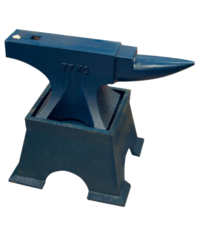Blacksmith's Anvil: Difference between revisions
From DT Online
(Created Article) |
m (Added link to Pritchel) |
||
| Line 3: | Line 3: | ||
Most have a '''Hardie Hole''' to support various tools and a '''Punch Hole''', which is also used for holding some tools, such as a '''Hold Down''' clamp to grip work on to the top '''Face''' of the anvil as it is being worked. | Most have a '''Hardie Hole''' to support various tools and a '''Punch Hole''' ''(aka [https://en.wikipedia.org/wiki/Pritchel Pritchel] Hole)'', which is also used for holding some tools, such as a '''Hold Down''' clamp to grip work on to the top '''Face''' of the anvil as it is being worked. | ||
The top '''Face''' is made of [https://en.wikipedia.org/wiki/Hardened_steel hardened steel], so that it can withstand repeated hammer blows, and has rounded edges to avoid the workpiece being cut into. The pointed end of an anvil is known as the '''Beak''' ''(or '''Bick''')'' and it is on this that ‘eyes’ are formed for example. Between the '''Face''' and the '''Beak''' is a small surface known as the '''Step'''. This is not hardened and is used for cutting on to avoid blunting the forge tools. | The top '''Face''' is made of [https://en.wikipedia.org/wiki/Hardened_steel hardened steel], so that it can withstand repeated hammer blows, and has rounded edges to avoid the workpiece being cut into. The pointed end of an anvil is known as the '''Beak''' ''(or '''Bick''')'' and it is on this that ‘eyes’ are formed for example. | ||
Between the '''Face''' and the '''Beak''' is a small surface known as the '''Step'''. This is not hardened and is used for cutting on to avoid blunting the forge tools. | |||
Revision as of 18:15, 12 December 2015
Together with a Forge, the Anvil is a major piece of equipment for Blacksmithing. The Anvil provides the surfaces over which most bending, forming and cutting is done.
Most have a Hardie Hole to support various tools and a Punch Hole (aka Pritchel Hole), which is also used for holding some tools, such as a Hold Down clamp to grip work on to the top Face of the anvil as it is being worked.
The top Face is made of hardened steel, so that it can withstand repeated hammer blows, and has rounded edges to avoid the workpiece being cut into. The pointed end of an anvil is known as the Beak (or Bick) and it is on this that ‘eyes’ are formed for example.
Between the Face and the Beak is a small surface known as the Step. This is not hardened and is used for cutting on to avoid blunting the forge tools.
